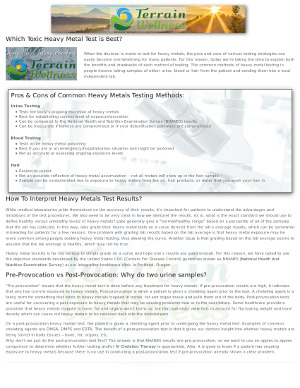Heavy Metals Testing Procedures:

Doctors Data Heavy Metal Test PDF
Elements like lead, mercury, cadmium and arsenic are all naturally occurring elements that are known for being particularly heavy and highly toxic to humans. Unfortunately, these elements are also used in many industries like construction, electronic devices and agriculture. While these elements can be encountered in nature, mining, farming, manufacturing and other human activities increase our risk of exposure to these toxic elements. One of the many organ systems harmed by heavy metals is the endocrine system, which is responsible for making and regulating hormones. The thyroid is part of this endocrine system that can suffer great damage from heavy metals, specifically cadmium, lead, mercury, and aluminum.
The short answer: we use urine samples tested via Doctor’s Data for measuring heavy metals and we evaluate these results based on US Centers for Disease Control NHANES standard. We don’t charge a commission for collecting the tests because we want these to be very affordable so everyone can get tested.
While the liver can process and detoxify harmful substances out of the body, heavy metals that cannot be eliminated are stored in fat and bone tissue. For more on that process, see our article on the three phases of liver detoxification.

For patients who have reason to suspect that they may have been exposed to toxic elements or chemicals at some point, the first formal step to take is pursuing heavy metal testing with a doctor experienced in evaluating and treating cases of heavy metal exposure. But, which test to get, and what are the pros and cons of different tests? The full answer is a bit complicated, but we’ll try to break it down in this article. Hospitals and many doctor’s offices generally use blood tests to check for heavy metals. But, blood tests are limited in that they are most effective at uncovering recent/acute exposure. However, people who may have been exposed to toxic substances in the past or over a long period of time may not be flagged on a blood test. So, what do we recommend for our patients? The short answer: we use urine samples tested via Doctor’s Data for measuring heavy metals and we evaluate these results based on US Centers for Disease Control NHANES standard. We don’t charge a commission for collecting the tests because we want these to be very affordable so everyone can get tested. Want the longer explanation? Please, read on!
Which Toxic Heavy Metal Test is Best?
When the decision is made to test for heavy metals, the pros and cons of various testing strategies can easily become overwhelming for many patients. For this reason, today we’re taking the time to explain both the benefits and drawbacks of each method of testing. The common methods of heavy metal testing in people involve taking samples of either urine, blood or hair from the patient and sending them into a local independent lab.
Pros & Cons of Common Heavy Metals Testing Methods:
- Urine Testing
-
- Tests the body’s ongoing excretion of heavy metals
- Best for establishing current level of exposure/excretion
- Can be compared to the National Health and Nutrition Examination Survey (NHANES) results
- Can be inaccurate if kidneys are compromised or if your detoxification pathways are compromised
- This is the heavy metals test we use: Doctors Data Heavy Metal Test PDF
- Blood Testing
-
- Tests acute heavy metal poisoning
- Best if you are in an emergency/hospitalization situation and might be poisoned
- Not as accurate at assessing ongoing exposure levels
- Hair
-
- Easiest to collect
- Not an accurate reflection of heavy metal accumulation – not all metals will show up in the hair sample
- Sample can be contaminated due to exposure of hair sample to heavy metals from the air, hair products, or water that you wash your hair in
How To Interpret Heavy Metals Test Results?
While medical laboratories pride themselves on the accuracy of their results, it’s important for patients to understand the advantages and limitations of the test procedures. We also need to be very clear in how we interpret the results. As in, what is the exact standard we should use to define healthy versus unhealthy levels of heavy metals? Labs generally give a “normal/healthy range” based on a percentile of all of the samples that the lab has collected. In this way, labs grade their heavy metal tests on a curve derived from the lab’s average results, which can be somewhat misleading for patients for a few reasons. One problem with grading lab results based on the lab average is that heavy metal exposure may be more common among people seeking heavy metal testing, thus skewing the curve. Another issue is that grading based on the lab average seems to assume that the lab average is healthy, which may not be true.
Heavy metal toxicity is far too serious to simply grade on a curve and hope one’s results are good enough. For this reason, we have opted to use the objective standards developed by the United States CDC (Centers For Disease Control) guidelines known as NHANES (National Health And Nutrition Examination Survey) at our integrative healthcare clinic in Portland, Oregon.
Pre-Provocation vs Post-Provocation: Why do two urine samples?
“Pre-provocation” means that the heavy metal test is done before any treatment for heavy metals. If pre-provocation results are high, it indicates that one has current exposure to heavy metals. Post-provocation is when a patient is given a chelating agent prior to the test. A chelating agent is a fancy term for something that binds to heavy metals trapped in bones, fat and organ tissue and pulls them out of the body. Post-provocation tests are useful for uncovering a past exposure to heavy metals that may be causing problems now or in the near-future. Some healthcare providers postulate that heavy metals trapped in bone, fat and organs won’t harm us; but that optimistic view fails to account for fluctuating weight and bone density which can cause old heavy metals to be released back into the bloodstream.
On a post-provocation heavy metals test, the patient is given a chelating agent prior to undergoing the heavy metal test. Examples of common chelating agents are DMSA, DMPS and EDTA. The benefit of a post-provocation test is that it gives our doctors insight into whether heavy metals are being stored in body tissues – bone, fat, organs, etc.
Why don’t we just do the post-provocation test first? The answer is that NHANES results are pre-provocation, so we want to use an apples-to-apples comparison to determine whether further testing and/or IV Chelation Therapy is appropriate. Also, it is good to know if a patient has ongoing exposure to heavy metals because there is no use in conducting a post-provocation test if pre-provocation already shows a clear problem.
Heavy Metals & Thyroid Health
At times, patients will have symptoms of declining thyroid health that can be traced back to the buildup of heavy metals in the body. Of course, the subject of testing for toxic heavy metals is complex and no single article can do such a complicated matter justice. Exposure to toxic heavy metals is a very serious/harmful health condition that often requires medical intervention. If you suspect that you have been exposed to heavy metals, please book a doctor’s appointment with us so we can help you.


